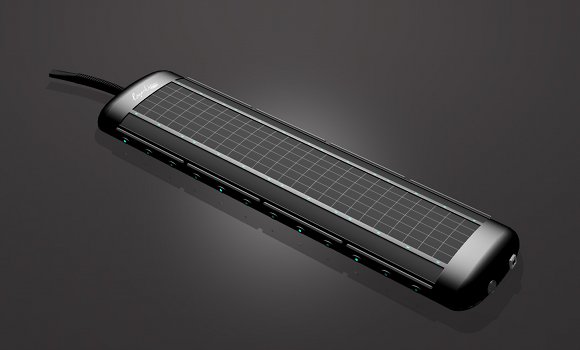We’ve lived so long with a musical world dominated by the piano keyboard that it can be hard to look beyond it. But for some time, musicians have desired a set of common requirements for what might replace it:
- The ability to hit specific pitches in a convenient layout, perhaps one more convenient than the piano, but also…
- The ability to express pitch between pitches (as most other instruments provide)
- Continuous pressure for expression, not only when a note is struck, but as it is played (again, as on most other instruments)
I’ve been talking to Roger Linn for a year or two now about his interest in finding something new to develop in music technology. He’s been working on a multitouch instrument. Unlike most current multitouch technology, as on the iPad, the key ingredient really is expressive pressure sensitivity. There have been various attempts to build instruments that do this, but it’s been tough to find one that could be produced in cost-efficient, scalable ways, and not just impressive one-off, handmade constructions. (Not that there’s anything wrong with that, of course.)
Late last night, Roger decided to make some of this work public. Tim Thompson, himself a multi-touch guru (he plays live with the FingerWorks software, teamed up with Roger and Roger’s wife Ingrid to build support for OSC, TUIO, and (for sound output in this example), Max/MSP. (Ingrid, by the way, is Roger Linn Design’s best-kept secret; she’s a terrifically-talented electrical engineer who has done a lot of the actual EE for the Linn instruments, and when I last talked to her, was taking pilot lessons.)
It’s not immediately apparent, but there’s even additional control of timbre on the y axis.
The results look and sound great, particularly considering this is a prototype. I’ve already got some questions in mind, but have a look at what Roger has to say and let us know if there’s anything you’d like me to ask him.
Note that what you see above is just a prototype. The rendering below shows some of the polish that could be applied to a final design.
Is this a great design? I think so. Is this something talented musicians will want, and practice, and get good at? Absolutely. Do things like the iPad allow anything like this? No – not without pressure, period. Are there other ways of compensating, like adding accelerometers or other controls? Yes – but that doesn’t matter, because the act of applying extremely sensitive variations in pressure at the fingertips is more intuitive. It’s the evolutionary achievement that allows us to pick up a coffee cup without alternatively dropping or crushing it. (If you don’t think that’s significant, ask someone who makes robotic arms – perhaps over a coffee.)
No, there’s just one bit of bad news — we need a new multitouch vendor for this kind of innovation to happen. (Anyone? Anyone? Bueller?)
The company that makes the tech Roger used, TouchCo, was bought by Amazon as part of the ongoing turf wars in multitouch technology. And that’s just the latest episode in a tech landscape that has brought a lot of bad news. Instead of multitouch research leading to the golden era of interaction innovation some (like myself) had been predicting, we instead face petty battles over who sells e-books and protracted patent wars over intellectual property, many of those waged by companies who produce nothing.
Stantum’s resistive (not capacitive) sensing, which I covered last month, does theoretically provide pressure, though I don’t know if it works as well as TouchCo’s or how it would even be licensed to a small instrument maker. One advantage versus the TouchCo surface above, of course, is that Stantum also adds a display. But that’s just one example.
So, somewhere, perhaps, there’s a vendor who’s a fan of Roger Linn. (Hey, you know he’s the father of the drum machine? The MPC? He’s kind of a big deal? Anyone?) Perhaps this will inspire our readers over at Stantum to do something. Perhaps a company we’ve never heard of who loves music or dreams of playing a solo with a multitouch square in their band.
Alternatively, perhaps there is a way to homebrew this kind of sensor without enormous cost. (There’s certainly quite a lot of research. I’d round that up, but … it’s a beautiful Saturday here in New York. Help me out.)
Whoever knows the answer: please, by the powers of the Internet, find this post. Find me. Find Roger. And by the almighty Zeus, don’t sell out to someone before we can make music.
Research Project: LinnStrument — A New Musical Instrument Concept
